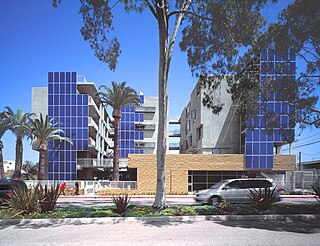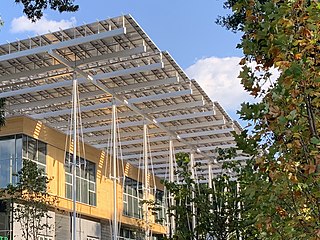
East Carolina University (ECU) is a public research university in Greenville, North Carolina. It is the fourth largest university in North Carolina and the only one in the state with both a medical school and a dental school.

Central New Mexico Community College (CNM), formerly Technical Vocational Institute (TVI), is a public community college based in Albuquerque, New Mexico. Founded in 1964, CNM offers associate degrees, professional certificates, and training options.

Green building refers to both a structure and the application of processes that are environmentally responsible and resource-efficient throughout a building's life-cycle: from planning to design, construction, operation, maintenance, renovation, and demolition. This requires close cooperation of the contractor, the architects, the engineers, and the client at all project stages. The Green Building practice expands and complements the classical building design concerns of economy, utility, durability, and comfort. Green building also refers to saving resources to the maximum extent, including energy saving, land saving, water saving, material saving, etc., during the whole life cycle of the building, protecting the environment and reducing pollution, providing people with healthy, comfortable and efficient use of space, and being in harmony with nature. Buildings that live in harmony; green building technology focuses on low consumption, high efficiency, economy, environmental protection, integration and optimization.’

The Nicholas School of the Environment is one of ten graduate and professional schools at Duke University and is headquartered on Duke’s main campus in Durham, N.C. A secondary coastal facility, Duke University Marine Laboratory, is maintained in Beaufort, North Carolina. The Nicholas School is composed of three research divisions: Earth and Climate Sciences, Environmental Sciences and Policy, and Marine Science and Conservation. The current dean of the Nicholas School is Toddi Steelman.

Leadership in Energy and Environmental Design (LEED) is a green building certification program used worldwide. Developed by the non-profit U.S. Green Building Council (USGBC), it includes a set of rating systems for the design, construction, operation, and maintenance of green buildings, homes, and neighborhoods, which aims to help building owners and operators be environmentally responsible and use resources efficiently.

Energy engineering is a broad field of engineering dealing with areas such as energy harvesting and storage, energy conversion, energy materials, energy systems, energy efficiency, energy services, facility management, plant engineering, energy modelling, environmental compliance, sustainable energy and renewable energy technologies. Energy engineering is one of the most recent engineering disciplines to emerge. Energy engineering combines knowledge from the fields of physics, math, and chemistry with economic and environmental engineering practices. Energy engineers apply their skills to increase efficiency and further develop renewable sources of energy. The main job of energy engineers is to find the most efficient and sustainable ways to operate buildings and manufacturing processes. Energy engineers audit the use of energy in those processes and suggest ways to improve the systems. This means suggesting advanced lighting, better insulation, more efficient heating and cooling properties of buildings. Although an energy engineer is concerned about obtaining and using energy in the most environmentally friendly ways, their field is not limited to strictly renewable energy like hydro, solar, biomass, or geothermal. Energy engineers are also employed by the fields of oil and natural gas extraction.
Perkins&Will is a global design practice founded in 1935. As of 2022, Perkins&Will had 28 offices and over 2,500 employees. In the same year, Perkins&Will generated $572.47 million in earnings, making it the second largest architecture firm by revenue in the United States. Phil Harrison has been the firm's CEO since 2006.
This article provides examples of green building programs in the United States. These programs span the public, private, and non-profit sectors, and all have the goal of increasing energy efficiency and the sustainability of the built environment.

Colorado Court Housing is a 44-unit housing project designed by the architectural firm Pugh + Scarpa. Colorado Court is the first United States Green Building Council (USGBC) "LEED" certified multi-family housing project, achieving "Gold" certification. Located at the corner of a main offramp of the Santa Monica freeway, Colorado Court's highly visible position makes it gateway to the city of Santa Monica, California. The 44-unit, five-story building is the first affordable-housing project the United States to be LEED certified and is nearly 100% energy neutral (Colorado Court Movie Clip). This project is an excellent model of sustainable development in an urban environment, provides a model for private/public partnerships benefit the community, and promotes diversity in an urban environment through strategically placed affordable housing.
Green building on college campuses is the purposeful construction of buildings on college campuses that decreases resource usage in both the building process and also the future use of the building. The goal is to reduce CO2 emissions, energy use, and water use, while creating an atmosphere where students can be healthy and learn.
Environmentally sustainable design is the philosophy of designing physical objects, the built environment, and services to comply with the principles of ecological sustainability and also aimed at improving the health and comfort of occupants in a building. Sustainable design seeks to reduce negative impacts on the environment, the health and well-being of building occupants, thereby improving building performance. The basic objectives of sustainability are to reduce the consumption of non-renewable resources, minimize waste, and create healthy, productive environments.

The Gies College of Business Instructional Facility (BIF) is a state-of-the-art business facility designed by Pelli Clarke Pelli Architects located on the Champaign campus at the University of Illinois Urbana–Champaign (UIUC).
LEED for Neighborhood Development (LEED-ND), where "LEED" stands for Leadership in Energy and Environmental Design, is a United States-based rating system that integrates the principles of smart growth, urbanism, and green building into a national system for neighborhood design. LEED certification provides independent, third-party verification that a development's location and design meet accepted high levels of environmentally responsible, sustainable development.

The UNC School of Information and Library Science(SILS) is a professional school at the University of North Carolina at Chapel Hill offering a bachelor's degree in information science, master's degrees in library science and information science, a professional science master's degree in digital curation, and a doctoral degree in information and library science as well as an undergraduate minor, graduate certificate programs, and a post-masters certificate.

"Sustainability," was defined as “development which implies meeting the needs of the present without compromising the ability of future generations to meet their own needs”as defined by the 1983 Brundtland Commission. As sustainability gains support and momentum worldwide, universities across the United States have expanded initiatives towards more sustainable campuses, commitments, academic offerings, and student engagement.
NASA Sustainability Base is located on the campus of NASA's Ames Research Center in Moffett Field, California. It was named in recognition of the first human outpost on the moon, Tranquility Base. It was designed to exhibit and test the latest energy-saving technologies as part of the federal government's drive to eliminate fossil-fuel consumption in all new government buildings by 2030. The building was not initially conceived as a "sustainability base", but associate director Steven Zornestzer worked with architect William McDonough to create an energy-efficient building for the 21st century. McDonough, previously published "Cradle to Cradle", which argued for building architecture to move out of the "life cycle" model and become a more circular system, lasting for indefinite periods of time. This belief, along with other influences from looking at urban design and architecture through a biological perspective, provided inspiration for the NASA Sustainability Base. Energy-saving features include water recycling, fuel cell electricity generation, natural lighting, solar panels, and a geothermal well system. The building takes advantage of the sun's arc and winds from San Francisco Bay in addition to being able to adjust to changes in sunlight, temperature, wind, and occupancy. Also, the building had normal budget and actually a shorter than normal production time. One of the nation's greenest buildings, the NASA Sustainability Base was awarded the U.S. Green Building Council's Leadership in Energy and Environmental Design (LEED) Platinum status. It was completed in December 2012 and cost $27.8 million.

The Wisconsin Energy Institute serves as the collaborative home of energy research and education for the University of Wisconsin-Madison campus and greater Midwestern region, and houses the Great Lakes Bioenergy Research Center, along with research space for the Nelson Institute for Environmental Studies.
In an effort to create a more sustainable environment, Clemson University, located in Clemson, South Carolina, has developed several initiatives to conserve energy and educate students along with the public about fossil fuels and natural resources. Clemson has set both short- and long-term goals, on a scale of up to 15 years. Known as the Solid Green campaign, Clemson has a mission to reduce total energy used by 20% in the year 2020, reach a goal of becoming net-zero in carbon emissions, and replace the coal-fired boiler in 2015. Clemson has the long-term desire to become much more energy efficient, climate considerate and recycle more. One way of funding these initiatives is the Student Sustainability Fee, also known as the Green Fee, which students can elect to pay $10 with their tuition each semester.

The Kendeda Building for Innovative Sustainable Design is a multi-disciplinary, non-departmental academic building on the main campus of the Georgia Institute of Technology in Atlanta, Georgia, United States. Construction began in 2017, with the building designed to be the first Living Building Challenge-certified academic building in the Southeastern United States. It opened in late September 2019 and achieved Living Building certification in March 2021. It is the first certified Living Building in Georgia and the 28th in the world. It was designed by architectural firms Lord Aeck Sargent and Miller Hull with 100% funding for design and construction from the Kendeda Fund.
The Institute for Energy Efficiency (IEE) is a research institute of the University of California, Santa Barbara (UCSB). IEE is an interdisciplinary research institute dedicated to the development of science and technologies that increase energy efficiency, reduce energy consumption, and support an efficient and sustainable energy future.












